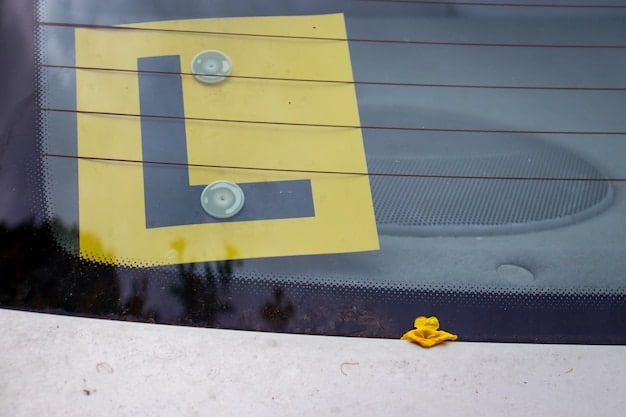2025 Car Buying: MSRP vs. Invoice Price vs. Market Value

Understanding the nuances of MSRP, invoice price, and market value is crucial for making informed car buying decisions in 2025, ensuring you get the best possible deal.
Navigating the car buying process can feel like deciphering a secret code. With the 2025 models hitting the market, understanding the distinctions between the Manufacturer’s Suggested Retail Price (MSRP), invoice price, and market value is more important than ever. Let’s break down these terms and empower you to negotiate confidently and get the best possible deal on your next vehicle.
MSRP Explained: What It Is and What It Isn’t
The acronym MSRP stands for Manufacturer’s Suggested Retail Price. It’s the price that the car manufacturer recommends the dealer sell the car for. Think of it as a starting point, but definitely not necessarily the final price you’ll pay.
MSRP often includes the base price of the vehicle, standard equipment, manufacturer installed options, and the destination charge. However, it typically doesn’t include state and local taxes, title, license, or dealer installed options.
Why is MSRP Important?
While you likely won’t pay MSRP, it serves as a benchmark. It allows you to compare prices across different dealerships and understand the value of different trim levels and packages. It’s also a factor in determining vehicle depreciation.
Factors Influencing MSRP
MSRP is influenced by several factors, including:
- Production costs: The cost of materials, labor, and manufacturing directly impacts the MSRP.
- Market demand: High demand for a particular model can lead to a higher MSRP.
- Competition: Manufacturers consider the prices of competing vehicles when setting the MSRP.
Understanding these factors can further empower you during negotiations. Remember, the MSRP is just a suggestion, and the actual selling price is often negotiable.

Unveiling the Invoice Price: The Dealer’s Cost
The invoice price represents what the dealership pays the manufacturer for the vehicle. Knowing this number can give you a significant advantage during negotiations, as it reveals the dealer’s baseline cost.
However, the invoice price isn’t always the dealer’s *true* cost. Dealers often receive incentives, rebates, and other forms of compensation from the manufacturer that aren’t reflected on the invoice.
Deciphering the Invoice
An invoice typically includes the following:
- Base price of the vehicle
- Cost of options and packages
- Destination charges
- Dealer holdback (a percentage of the MSRP that the manufacturer reimburses the dealer after the sale)
Finding the Invoice Price
Obtaining the exact invoice price can be tricky. While dealers aren’t obligated to disclose it, here are some ways to find it:
- Online resources: Websites like Edmunds and Kelley Blue Book often provide estimated invoice prices.
- Car buying services: These services negotiate on your behalf and often have access to invoice pricing.
- Be direct: While it is a long shot, you can simply ask the dealer for the invoice price.
Even with an estimated invoice price, you’ll have a much better understanding of the dealer’s potential profit margin, empowering you to negotiate a more favorable price.
Market Value: The Real-World Price of the Car
Market value reflects what buyers are actually paying for a vehicle in a specific region and at a specific time. In other words, it’s the price point where supply and demand meet. This number fluctuates based on many circumstances.
Unlike MSRP and invoice price, market value is dynamic and influenced by a variety of external factors. It represents the true worth of the vehicle in the current market conditions.
Factors Influencing Market Value
Several factors contribute to the market value of a car, including:
- Supply and Demand: High demand and low supply will drive up market value. Conversely, low demand and high supply will lower prices.
- Incentives and Rebates: Manufacturer and dealer incentives can significantly reduce the market value.
- Regional Variations: Market value can vary depending on your location due to differences in demand and local taxes.
- Economic Conditions: Overall economic health impacts consumer spending and, consequently, car prices.
Keeping these aspects in mind can set you up to purchase at the right point in time. For instance, you might find better deals at the end of a model year or during traditional sales events.
Strategies for Negotiating the Best Price in 2025
Knowing the MSRP, invoice price, and market value is only half the battle. The real challenge lies in negotiating a price that works for you. Here are some strategies to help you negotiate confidently and maximize your savings.
Preparation is the key to a successful negotiation. The knowledge that you’ve gained from understanding the different prices of a car gives you a significant advantage, but it’s important to use it correctly.
Research and Preparation
Before heading to the dealership, do your homework:
- Know your budget: Determine how much you can afford to spend before you start shopping.
- Research incentives: Check for manufacturer and dealer incentives that you may qualify for.
- Get pre-approved for a loan: Knowing your interest rate and loan terms beforehand strengthens your negotiating position.
Negotiation Tactics
During negotiations, consider these tactics:
- Start low: Make an initial offer that is below the invoice price.
- Be willing to walk away: Don’t be afraid to leave if the dealer isn’t willing to meet your price.
- Focus on the out-the-door price: This is the total price, including all taxes and fees.
Leveraging Information
Use your knowledge of MSRP, invoice price, and market value to your advantage:
- Highlight discrepancies: Point out any significant differences between the MSRP and market value.
- Use competitor quotes: Show the dealer quotes from other dealerships to leverage a lower price.
- Be informed about incentives: Make sure the dealer is applying all applicable incentives and rebates.

The Impact of Electric Vehicles (EVs) on Car Pricing in 2025
The rise of electric vehicles (EVs) is reshaping the automotive landscape, and their impact on car pricing is significant. As EVs become more mainstream, understanding their unique characteristics is essential for making informed buying decisions in 2025.
One major factor is the federal tax incentives to promote ownership. Those incentives have pushed manufacturers to create some competitive prices.
EV Incentives and Rebates
Government incentives and rebates can significantly reduce the cost of EVs:
- Federal tax credits: These credits can lower your tax liability and make EVs more affordable.
- State and local incentives: Many states and local governments offer additional incentives for EV purchases.
- Utility company rebates: Some utility companies offer rebates for installing EV charging equipment at your home.
EV-Specific Negotiation Strategies
When negotiating the price of an EV, consider these strategies:
- Factor in long-term savings: EVs typically have lower running costs due to reduced fuel and maintenance expenses.
- Inquire about battery warranties: Ensure you understand the terms and conditions of the battery warranty.
- Negotiate the price of charging equipment: Include the cost of a home charger in your negotiations.
The Future of EV Pricing
EV prices are expected to continue to decline as battery technology improves and production costs decrease. As EVs become more accessible and affordable, they will play an increasingly significant role in the car buying market.
Navigating the Car Buying Process Online in 2025
The internet has revolutionized the car buying process, making it easier than ever to research, compare prices, and even purchase a vehicle entirely online. In 2025, online car buying platforms will continue to evolve, offering consumers greater convenience and transparency.
Shopping online may seem like a straightforward process, but it can often be just as tricky to navigate. There are a few things to keep in mind before going this route.
Benefits of Online Car Buying
Online car buying offers several advantages:
- Convenience: Shop from the comfort of your own home, at any time.
- Transparency: Access to pricing information, vehicle history reports, and customer reviews.
- Wider selection: Search for vehicles across multiple dealerships and locations.
Tips for Successful Online Car Buying
To ensure a smooth online car buying experience, follow these tips:
- Read reviews: Check customer reviews of dealerships and vehicles to get an unbiased perspective.
- Verify pricing: Confirm that the online price includes all applicable fees and incentives.
- Inspect the vehicle: If possible, inspect the vehicle in person before finalizing the purchase.
Potential Pitfalls to Avoid
Be aware of potential pitfalls when buying a car online:
- Hidden fees: Watch out for unexpected fees that may not be disclosed upfront.
- Misleading information: Verify the accuracy of vehicle descriptions and specifications.
- Shipping costs: Factor in the cost of shipping the vehicle to your location.
| Key Concept | Brief Description |
|---|---|
| 💰 MSRP | Manufacturer’s Suggested Retail Price; a starting point for negotiation. |
| 🧾 Invoice Price | What the dealership pays the manufacturer; reveals dealer’s baseline cost. |
| 📈 Market Value | The current real-world price buyers are paying, influenced by supply and demand. |
| 💡 Negotiation | Preparation and research are essential for negotiating the best possible price. |
What is MSRP?
MSRP stands for Manufacturer’s Suggested Retail Price, the recommended price a manufacturer suggests a dealer sell a car for.
Does the invoice price always reflect the dealer’s true cost?
The invoice price is what the dealer pays the manufacturer, but it doesn’t always reflect their true cost after considering incentives and holdbacks.
What factors influence the market value of a car?
Market value is influenced by supply and demand, incentives, regional variations, and overall economic conditions.
Can I negotiate the price of a car below the invoice price?
Yes, it’s possible to negotiate a price below the invoice price, especially during sales events or when demand is low.





